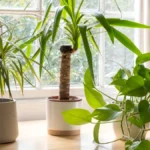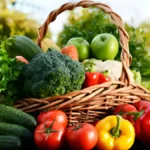Basil, one of the most utilized herbs in the world, is famous for its many culinary and medicinal uses from India to Italy. The intensely fragrant leaves are a vital component of many well-known dishes, including Vietnamese, Thai, and Italian. Basil is well-known for its nutritional value and health advantages. It is a good source of antioxidants, trace minerals, and vitamins. Learning how to grow basil in your own house, be it on a sunny windowsill, garden, or balcony, may be a fulfilling experience.
Instructions on how to grow basil:
- Warm, bright areas are ideal for basil growth. Choose a spot that gets at least 6 to 8 hours of sunlight each day.
- Basil is a heat-loving plant that can become stressed by the cold. Hold off until the weather is consistently in the 70s during the day and over 50 degrees F at night, which is in late spring or early summer.
- Basil likes its soil to have a high organic content and good drainage. Make sure the soil is rich and loose. To improve the soil’s quality, you can add old manure or compost.
- Basil can be grown from seeds or transplanted from a nursery as seedlings. When directly sowing seeds, make sure they are buried in the ground about ¼ inch. When transplanting, give the seedlings a 6–8 inch gap between them.

How to grow basil with proper care:
- Don’t let plants dry out; instead, keep them evenly hydrated. Underwatering can result in stressed or wilted plants while overwatering can lead to fungal diseases and root rot. Watering in the morning is ideal to prevent sopping the leaves.
- There is rarely a need for additional fertilizer when the soil is well-amended. Rapid growth brought on by overfertilization may produce a loss of flavor. During the growing season, apply an all-purpose organic liquid fertilizer at half intensity once or twice if needed. Fertilize once a month as nutrients will leak out of containers more quickly.
- To promote bushier growth and keep the basil plant from blossoming too soon, pinch off the tips of the plant regularly. When harvesting leaves, take care not to take off more than one-third of the plant at once.
- Tomatoes, peppers, and other herbs like cilantro and parsley thrive well with basil. When planted together, they can ward against pests and enhance general plant health.
Conclusion:
In conclusion, gardeners of all skill levels can find pleasure and fulfillment in learning how to grow basil. You can grow robust basil plants that will give you a consistent supply of fresh herbs for flavoring and cooking by adhering to these simple guidelines. Adding basil to your garden can enhance the flavor, aroma, and aesthetic appeal of your outdoor area, regardless of your level of gardening expertise. Now gather your gardening tools, roll up your sleeves, and get ready to enjoy a plentiful harvest of your basil!
Certainly! If you’d like to learn more, please consider following our WhatsApp Channel: Harvest Gardening
A frequently asked questions:
Q1: How to grow basil indoors?
A1: Basil can be grown indoors with proper drainage, regular watering, and placement in a sunny area to avoid root rot.
Q2: What type of soil is best for growing basil?
A2: Well-draining soil with a pH of 6.0 to 7.5 is ideal for basil growth. For best results, use a light, healthy soil mixture that has been enhanced with compost.
Q3: How do I harvest basil leaves?
A3: To cut basil leaves, pinch off individual leaves or cut the stems above the leaf nodes. Frequent harvesting increases plant longevity and promotes bushier growth.




3 Comments
Pingback: How to Grow Herbs Successfully: Learn Practical Tips
Pingback: How to Grow Herbs Successfully: Learn Practical Tips
Pingback: How to Propagate Basil: Best Beginner's Guide